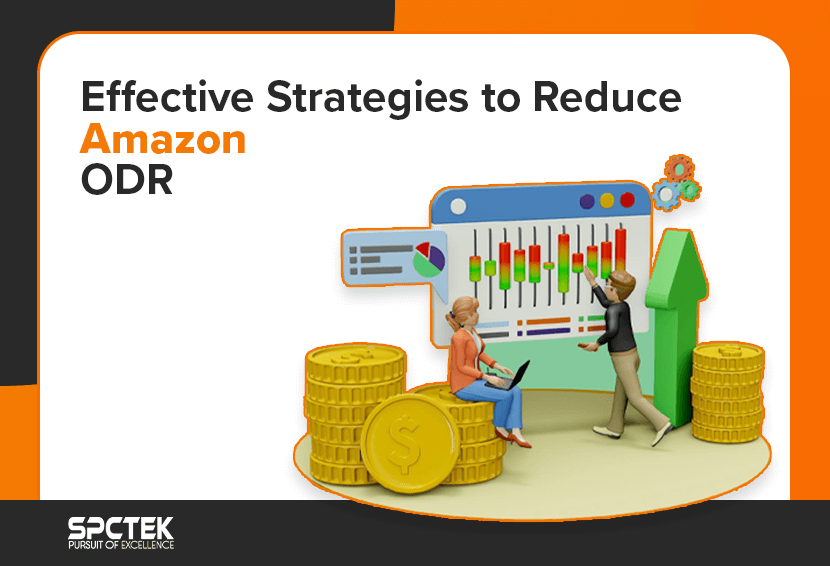Do you feel like your Amazon sales aren’t reaching their full potential? Your Order Defect Rate (ODR) might be the hidden factor. A high Amazon ODR can hurt your seller account health rating, limit your visibility, and frustrate your customers.
But did you know that a small drop in ODR can make a huge difference? For instance, reducing your Amazon ODR by just 0.5% can significantly increase your seller ranking and buy box chances. Amazon considers ODR in assessing overall account health performance; keeping it low can increase visibility and sales.
However, only a few unsatisfied customers or late shipments can spoil your ODR; therefore, monitoring and timely addressing issues is necessary. Let’s discuss the best strategies to control ODR in 2024 for better account health, increased sales, and customer satisfaction.
What is Amazon ODR (Order Defect Rate)?
Amazon ODR (Order Defect Rate) is an essential metric that tracks sellers’ performance in terms of how well they meet customer expectations. The ODR tells the percentage of all orders with defects, resulting in a bad customer experience. Negative feedback, A-to-Z guarantee claims, and chargeback claims are the main reasons behind a defective order.
Importance of Maintaining a Low ODR
For Amazon sellers, keeping the Order Defect Rate (ODR) low is crucial. An ODR of under 1% is essential for a successful seller, though this may vary slightly with shifts in industry standards and Amazon’s internal metrics.
A low ODR reflects high customer satisfaction, leading to stronger sales growth, enhanced product visibility, and increased consumer trust. The true value of a low ODR lies in its direct impact on boosted sales, improved seller ranking, and sustainable business growth on Amazon.
Exceeding acceptable ODR levels can have serious repercussions, including performance warnings or even account suspension. Therefore, consistent ODR monitoring and proactive management are vital to avoid any ODR-related penalties.
Amazon’s ODR Metrics

The Order Defect Rate (ODR) from Amazon is an essential measure of how well a seller performs. It consists of three key metrics:
- Negative Feedback: This consists of reviews from customers expressing dissatisfaction with their purchase or experience. Typically, it highlights issues like poor product quality or unsatisfactory services, leading to negative reviews that lower seller ratings and impact overall performance on Amazon.
- A-to-z Guarantee Claims: When a buyer files an A-to-z guarantee claim against a seller, it directly affects the Order Defect Rate (ODR). These claims commonly arise from issues such as non-delivery, items not matching descriptions, or receiving damaged products.
- Chargeback Claims: This measures the percentage of cases where customers dispute transactions through their bank or credit card provider, often resulting in refunds. These claims can also impact the seller’s ODR.
Also Read: Understanding Amazon Account Health Metrics That Matter
How Amazon Calculates ODR
Amazon calculates ODR over a rolling 60-day period. The formula is relatively straightforward:
- ODR = (No. of Defective Orders) / (No. of Total Orders) * 100

If 5 out of 100 orders are returned within a month, your Amazon Order Defect Rate will be 5%.
Order defects include the above order cancellations, late shipments, and claims under A-to-z guarantee.
Common Reasons for High ODR
A high Order Defect Rate (ODR) can stem from various issues. Understanding these common culprits is crucial for developing effective strategies to improve ODR.
1. Inventory Management Issues
- Stockouts & Overstocking: When companies tie up excess inventory and increase the storage costs, this could lead to liquidation or discounts, which will eventually impact your profits negatively. A lack of inventory can also result in order cancellation and unhappy customers.
- Inaccurate Inventory Data: There can be order cancellations or delayed shipments due to discrepancies between physical and system inventory.
2. Order Fulfillment Challenges
- Shipping Delays: Late shipments directly impact ODR. Factors like carrier delays, incorrect shipping addresses, or inefficient packing processes can contribute to this.
- Packaging Issues: Poorly packaged products can lead to damage during transit, which can cause returns and A-to-z claims.
- Order Processing Errors: Mistakes in order processing, such as wrong item choice or wrong quantities usually contribute to delays and customer dissatisfaction.
3. Customer Service Problems
- Poor Communication: Not communicating effectively or timely manner with customers may escalate grievances, resulting in further negative criticism or A-to-z claims.
- Inefficient Returns Process: A complex returning procedure may prevent customers from taking things back, resulting in dissatisfaction or A-to-z claims.
- Unresolved Customer Issues: Customers’ unresolved problems may negatively impact relations leading, to increased chances of negative feedback.
4. Product Quality Concerns
- Defective Products: Sending out defective or damaged products is a direct path toward increased returns and A-to-z claims.
- Inaccurate Product Descriptions: Misleading product information can lead to customer dissatisfaction and returns.
- Image Quality Issues: Poor product pictures can create unrealistic expectations, leading to returns.
5. Fraudulent Claims
- Buyer Fraud: Although rare, fraudulent A-to-z claims may also have a direct effect on ODR. Implementation of such risks requires the implementation of appropriate fraud prevention measures.
Effective Strategies for Sellers to Reduce Amazon ODR
Now that we’ve covered why managing your Amazon ODR is so important, let’s dive into practical strategies you can use to keep your ODR low and your account in top shape.
1. Improve Product Quality and Descriptions
To improve ODR (Order Defect Rate), ensure product quality, and provide accurate descriptions. Be straightforward in your product descriptions to avoid ambiguity over what the customers are buying. Using quality photos that genuinely reflect your products is also necessary. This helps set the right expectations and keeps customers happy, which can lower your Amazon order defect rate.
2. Enhance Shipping and Handling Processes
Use dependable shipping methods to prevent any delays and dissatisfactions. Promptly processed and shipped orders will keep customers happy. Proper packaging is also essential, as it should be able to protect your goods from damage or returns.
3. Provide Exceptional Customer Service
Exceptional customer service is another key to managing your Amazon ODR. Respond to customers faster, address their issues promptly, and create an easy return policy. Resolving issues efficiently can significantly improve your Amazon order defect rate and customer retention.
4. Monitor and Analyze ODR Metrics
Keep a close eye on your ODR metrics by regularly checking your performance. Look for trends and areas where you can improve. Amazon’s performance reports are a great tool for tracking and analyzing your ODR-related data, helping you make smart decisions to keep your numbers in check.
5. Implement Preventive Measures
Implementing preventive measures is essential to staying ahead in the online marketplace. Set up quality control processes to ensure that products meet the required standards before they are dispatched. Utilize automated systems for managing your stock and tracking orders to avert any problems that may affect your ODR.
Also Read: Amazon Negative Feedback Removal Secrets That Most Sellers Don’t Know
The Impact of High ODR on Amazon Sellers’ Business
A high Order Defect Rate (ODR) can seriously hurt an Amazon seller’s business. Here’s how:
- Lowered Seller Metrics: A high Amazon ODR signals problems with your order fulfillment or customer service. It can badly impact your seller’s performance metrics that resulting in lower ratings and Amazon visibility.
- Reduced Buy Box Eligibility: Your chances of winning the Buy Box could be lost if your ODR is high. Amazon prefers sellers with low defect rates, which means that having a high ODR will limit your ranking and visibility.
- Risk of Account Suspension: A persistently high Amazon order defect rate puts you at risk of account suspension. Amazon takes performance seriously, and failing to manage your ODR can lead to your account being temporarily or permanently suspended.
- Customer Dissatisfaction: High ODR often reflects issues with product quality or service, leading to customer dissatisfaction and negatively impacting your business reputation and account health.
- Difficulty in Growing Your Business: A high ODR can limit your growth opportunities. Poor performance affects your eligibility for promotions and advertising options, making it harder to scale your business.
Reducing your Amazon ODR is crucial for improving your performance and growing your business. Addressing these issues will help you maintain a strong seller account and keep your customers satisfied.
Also Read: How to Appeal Your Amazon ASIN Suspension?
Best Tips to Lower ODR
- Analyze ODR Components: Determine which part (order cancellations, late shipments, or A-to-Z claims) leads the way to your overall ODR.
- Leverage Amazon Tools: Improve your performance by using Amazon’s tools and programs like FBA, Seller Fulfilled Prime, and Amazon customer metrics.
- Seek Professional Help: You can seek professional help from an Amazon seller consultant if you find it difficult to lessen your ODR.
Wrapping up
In conclusion, maintaining an Amazon ODR below 1% is essential for a healthy and successful seller account. By enhancing product quality and descriptions, optimizing shipping and handling, delivering exceptional customer service, and regularly monitoring ODR metrics, sellers can keep their defect rate low.
Effective ODR management is about more than just avoiding penalties; it’s about creating seamless, positive experiences for customers. Following these strategies closely and keeping your ODR below 1% will drive success for your brand, increase your chances of securing the Buy Box, and maximize sales on Amazon.
At SPCTEK, we are dedicated to helping you achieve a low ODR and grow your Amazon business. Our team of experts is here to support you in implementing these strategies effectively, ensuring your account remains in top condition. Improving your Amazon Order Defect Rate starts with prioritizing customer satisfaction and continually striving to exceed expectations.
Got More Questions?
Amazon Order Defect Rate (ODR) measures the percentage of orders with negative customer experiences, including cancellations, late shipments, and A-to-Z Guarantee claims. It’s a key metric for assessing seller performance and account health.
A high ODR can negatively impact your seller account, reduce visibility, and increase the risk of account suspension. Managing ODR effectively helps maintain a good seller rating, improve sales, and enhance customer satisfaction.
To improve your Amazon ODR, focus on enhancing product quality with accurate descriptions and high-resolution images. Ensure timely and reliable shipping with proper packaging. Provide exceptional customer service by responding quickly and resolving issues efficiently.
A high ODR can lead to lower seller metrics, reduced Buy Box eligibility, account suspension, and increased operational costs. It can also harm your reputation and customer satisfaction, limiting your business growth.
Regularly monitor your ODR metrics, ideally on a weekly or bi-weekly basis, to identify trends and address issues promptly. Frequent checks help maintain a low ODR and ensure continued compliance with Amazon’s performance standards.






